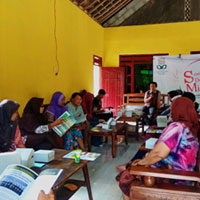Pemberdayaan Buruh Migran Masyarakat Pesisir Kulon Progo Melalui Pemanfaatan Kelapa Menjadi Nata de Coco
DOI:
https://doi.org/10.14421/jbs.3707Keywords:
Kelapa, Nata De Coco, Buruh MigranAbstract
Kelapa (Cocos nucifera) adalah tanaman yang dapat dimanfaatkan hampir semua bagiannya oleh manusia dan dianggap sebagai tumbuhan serbaguna bagi masyarakat, khususnya daerah pesisir di ujung Kulonprogo. Di daerah tersebut banyak dijumpai pohon kelapa yang tumbuh namun belum pernah dibuat oleh warga pengolahan kelapa yang menghasilkan nilai ekonomis kelapa lebih meningkat. Oleh karena itu diperlukan program pelatihan dan pendampingan pembuatan nata de coco dari kelapa yang merupakan sumber daya alam melimpah dan belum dimanfaatkan secara maksimal. Pelatihan tersebut dapat memberikan pengalaman bagi warga purna migran dalam berkreasi menciptakan sebuah produk rumah tangga. Harapan dilakukannya program pelatihan pembuatan nata de coco tersebut supaya dapat memberdayakan masyarakat buruh migran di Pasir Mendit, Kulonprogo, meningkatkan skill ibu rumah tangga dalam usaha menaikkan kesejahteraan masyarakat. Berdasarkan analisis kuisioner kemanfaataan pelatihan urutan variabel adalah kemanfaatan ekonomi (4.533) dengan standard deviasi (0.74322) disusul dengan variabel keterjangkauan biaya utama (air kelapa) dengan rata-rata (4.2) dan standard deviasi (0.7745). Dua variabel terendah yakni kemudahan identifikasi kegagalan dengan rata-rata 3.133 dan standard deviasi 1.125 dan variabel kemudahan penyimpanan dengan rata-rata 3 dan standard deviasi 0.845.
[Coconut (Cocos nucifera) is a plant that can be used in almost all parts by humans and is considered a versatile plant for the community, especially the coastal area at the end of Kulonprogo. In that area, there are many coconut trees that grow but have never been made by the coconut processing community which results in an increased economic value of coconuts. Therefore, it requires a training program and assistance in making nata de coco from coconut, which is an abundant natural resource that has not been fully utilized. This training can provide experience for former migrant citizens in creating a household product. The benefit of the training program for making nata de coco can empower the migrant worker community in Pasir Mendit, Kulonprogo, to improve the skills of housewives in an effort to improve community welfare. Based on the questionnaire analysis, the variable order training benefit is economic benefit (4,533) with a standard deviation (0.74322) followed by the main cost affordability variable (coconut water) with an average (4.2) and a standard deviation (0.7745). The two lowest variables were the ease of identification of failures with a mean of 3.133 and a standard deviation of 1.125 and the variable of ease of storage with a mean of 3 and a standard deviation of 0.845.]
References
Sutanto, Ratuca Steffie, Rahayuni, Arintina. 2013. Pengaruh pemberian ph substrat terhadap kadar serat, vitamin c, dan tingkat penerimaan nata de cashew (anacardium occidentale l.) Journal of Nutrition College, Volume 2, Nomor 1, Tahun 2013, Halaman 200-206 Online di: http://ejournal-s1.undip.ac.id/index.php/jnc
Choiroel anam, M. Zukhrufuz Zaman, Umu Khoirunnisa, 2019. Mengungkap Senyawa Pada Nata De Coco Sebagai Pangan Fungsional, Jurnal Ilmu Pangan dan Hasil Pertanian Vol. 3 No. 1 Thn. 2019 DOI: http://doi.org/10.26877/jiphp.v3i1.3453.
Daftar Analisis Bahan Makanan. Jakarta: Fak. Kedokteran UI; 1992
Ratnawati, Devi. 2007. Kajian Variasi Kadar Glukosa Dan Derajat Keasaman (Ph) Pada Pembuatan Nata De Citrus Dari Jeruk Asam (Citrus Limon. L). Jurnal Gradien, Vol. 3, No. 2, Hal: 257-261.
Rizal, Hardi Mey., Dewi Masria Pandiangan dan Abdullah Saleh. 2013. Pengaruh Penambahan Gula, Asam Asetat dan Waktu Fermentasi Terhadap Kualitas Nata De Corn. Jurnal Teknik Kimia, No. 1, Vol. 19, Hal: 34-39.
Pambayun, R. 2002. Teknologi Pengolahan Nata de Coco. Kanisius. Yogyakarta.
Patty, Zeth. 2012. Analisis Produkktivitas dan Nilai Tambah Kelapa Rakyat (Studi kasus di 3 kecamatan di Kabupaten Halmahera Utara). https: perperjurnalee.files.wordpress.comper2012per12peranalisis-produktivitas-dan-nilaitambah-kelapa-rakyat.pdf
http://www.tribunnews.com/bisnis/2017/06/08/produksi-terus-merosot-indonesia-mulai-krisis-kelapa.

Downloads
Published
How to Cite
Issue
Section
License
Copyright (c) 2022 Sofa Mauliyana, Tutik Farihah, Didik Krisdiyanto

This work is licensed under a Creative Commons Attribution-NonCommercial-ShareAlike 4.0 International License.
Authors who publish with this journal agree to the following terms:
- Authors retain copyright and grant the journal right of first publication with the work simultaneously licensed under a Creative Commons Attribution-NonCommercial-ShareAlike 4.0 International (CC BY-NC-SA 4.0) that allows others to share the work with an acknowledgement of the work's authorship and initial publication in this journal.
- Authors are able to enter into separate, additional contractual arrangements for the non-exclusive distribution of the journal's published version of the work (e.g., post it to an institutional repository or publish it in a book), with an acknowledgement of its initial publication in this journal.
- Authors are permitted and encouraged to post their work online (e.g., in institutional repositories or on their website) prior to and during the submission process, as it can lead to productive exchanges, as well as earlier and greater citation of published work.





